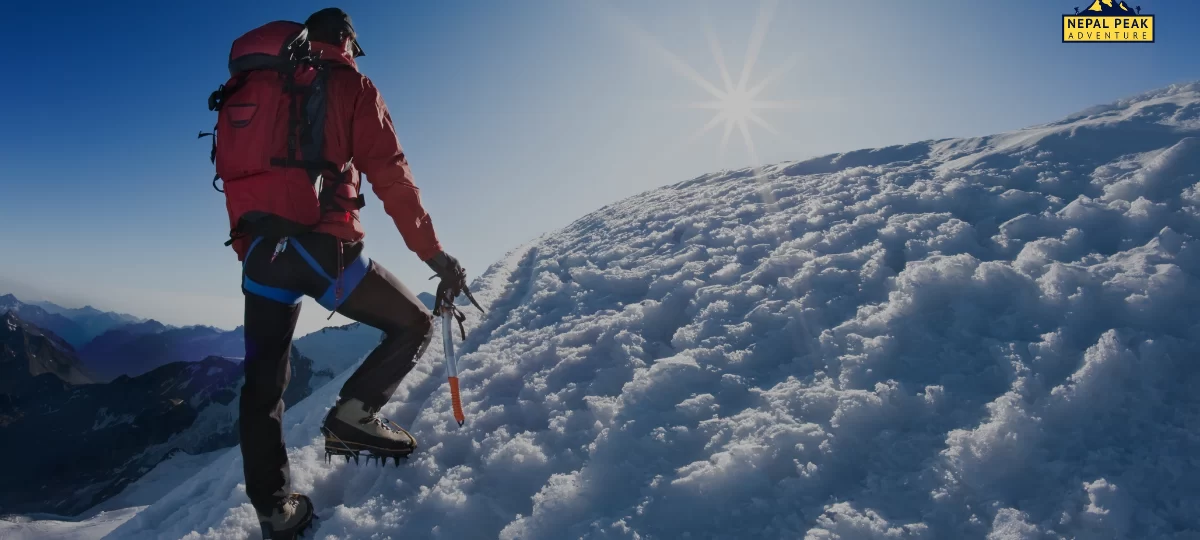Safety Tips for Peak Climbing in Nepal
Nepal is a dream destination for mountaineers and adventure seekers, offering some of the world’s most breathtaking peaks. From the famous Everest Base Camp to technical summits like Mera Peak and Island Peak, Nepal provides diverse climbing experiences for both beginners and experienced climbers. However, with high-altitude mountaineering comes inherent risks, including extreme weather conditions, altitude sickness, and technical climbing challenges. Proper preparation and awareness of safety measures are essential for a successful and injury-free expedition.
Moreover, Nepal is home to over 1,300 identified peaks, with 414 officially open for climbing. Popular trekking peaks include Island Peak (6,189m), Mera Peak (6,476m), and Lobuche East (6,119m). These peaks require permits from the Nepal Mountaineering Association (NMA) or the Department of Tourism. Climbing fees vary based on the peak’s difficulty and season. Additionally, climbers must submit essential documents like a passport copy, travel insurance, and medical clearance.
Whether you’re tackling an easier trekking peak like Island Peak or a more challenging one like Mera Peak, ensuring safety should always be your top priority. In this guide, we will discuss essential safety tips for peak climbing in Nepal, helping you prepare for a successful and secure adventure.
Understanding the Risks of Peak Climbing
Altitude Sickness and Its Effects
One of the biggest risks in peak climbing is altitude sickness. Symptoms such as headaches, dizziness, nausea, and shortness of breath can quickly escalate into serious conditions like High-Altitude Pulmonary Edema (HAPE) and High-Altitude Cerebral Edema (HACE). Understanding these risks and knowing how to mitigate them is essential.
Unpredictable Weather Conditions
Nepal’s mountain weather is highly unpredictable. Sudden snowfall, strong winds, and extreme cold can make climbing dangerous. Always check the weather forecast before your ascent and be prepared for rapid changes.
Physical and Mental Challenges
Peak climbing is not just a physical challenge but a mental one too. Harsh conditions, exhaustion, and prolonged exposure to high altitudes can test your endurance. Proper preparation and mental resilience are key.
Proper Preparation Before the Peak Climb
Choosing the Right Peak
Beginners should opt for peaks like Island Peak or Lobuche East, while experienced climbers can take on more demanding summits like Ama Dablam. Research the difficulty level before making a choice.
Getting Necessary Permits and Documents
Climbing in Nepal requires various permits, including the Nepal Mountaineering Association (NMA) permit, TIMS card, and national park entry permits. Ensure all paperwork is in order before starting your journey.
Selecting a Reputable Trekking and Climbing Agency
A trustworthy agency provides experienced guides, porters, and logistical support, ensuring a smoother and safer climbing experience. Nepal Peak Adventure is your trusted trekking and climbing agency in Nepal.
Now let’s dive into the safety tips for peak climbing in Nepal.
1. Choose the Right Season
Timing plays a crucial role in peak climbing. The best seasons are spring (March to May) and autumn (September to November). These periods offer stable weather, clear skies, and moderate temperatures, making them ideal for climbing.
During winter (December to February), temperatures drop significantly, making climbing more difficult and increasing the risk of frostbite and hypothermia. In the monsoon season (June to August), heavy rainfall makes trails slippery and increases the risk of landslides and avalanches. Choosing the right season helps ensure a safer and more enjoyable climb.
2. Train and Prepare Physically
Peak climbing is a physically demanding activity that requires strength, endurance, and stamina. It is essential to train at least three to six months before your climb. Your training regimen should include:
Cardiovascular exercises: Running, cycling, and swimming improve lung capacity and endurance.
Strength training: Focus on legs, core, and upper body to handle the climb’s physical demands.
Altitude training: If possible, practice hiking in high-altitude areas to get used to lower oxygen levels.
Stair climbing and hiking: Simulates real climbing conditions and improves leg strength and endurance.
Good physical fitness reduces fatigue, improves stamina, and helps you handle extreme conditions better.
3. Acclimatize Properly
Altitude sickness is a serious risk when climbing peaks in Nepal. It occurs due to a lack of oxygen at high altitudes and can be life-threatening if not addressed. To acclimatize properly:
Ascend gradually: Avoid climbing more than 500 meters per day above 3,000 meters.
Stay hydrated: Drink plenty of water to keep your body functioning properly.
Take rest days: Give your body time to adjust to the altitude.
Recognize symptoms early: Headache, dizziness, nausea, and shortness of breath are warning signs.
Descend if necessary: If symptoms worsen, descend immediately and seek medical help.
Eat a high-calorie diet: Carbohydrates help maintain energy levels at high altitudes.
Ignoring acclimatization guidelines can result in altitude sickness, which can be dangerous and even fatal.
4. Hire an Experienced Guide and Porter
An experienced guide is crucial for a successful climb. Certified guides have expert knowledge of the terrain, weather conditions, and emergency response. Their presence significantly increases safety, as they can:
Provide navigation support: Avoid getting lost in unfamiliar trails.
Offer first aid assistance: In case of injuries or altitude sickness.
Manage logistics: Arrange accommodation, food, and permits.
Assist with climbing techniques: Teach proper use of ropes and equipment.
Porters help carry heavy loads, allowing climbers to focus on the ascent without excessive physical strain. Hiring a guide and porter improves safety and overall climbing efficiency.
5. Use Quality Climbing Gear
Having high-quality gear is essential for safety and comfort. Essential climbing equipment includes:
Climbing boots: Must be warm, waterproof, and provide good grip.
Crampons and ice axes: Necessary for walking on icy or snowy terrain.
Helmet: Protects against falling rocks and ice.
Harness, ropes, and carabiners: Ensure safety while ascending steep slopes.
Insulated clothing: Layered clothing to protect against extreme cold.
Gloves, sunglasses, and sunscreen: Protects from sunburn and snow blindness.
Using poor-quality or ill-fitting gear increases risks and discomfort during the climb.
6. Check Weather Conditions
The Himalayas are known for unpredictable weather changes. Always check weather forecasts before and during the climb. Sudden storms, snowfall, or high winds can make climbing dangerous. To stay safe:
Monitor weather updates regularly.
Be flexible with your schedule and prepared for delays.
Avoid climbing in extreme weather conditions.
If bad weather strikes, consider delaying or postponing your climb to avoid unnecessary risks.
7. Get the Necessary Permits
Climbing in Nepal requires permits issued by government agencies. The required permits include:
Nepal Mountaineering Association (NMA) permit: Required for climbing trekking peaks.
TIMS (Trekkers’ Information Management System) card: Helps track trekkers for safety.
National Park or Conservation Area permits: Required for areas such as Sagarmatha and Annapurna.
Obtaining the proper permits ensures compliance with regulations and helps in emergency tracking if needed.
8. Follow a Proper Diet
Proper nutrition is essential for maintaining strength and stamina. Recommended foods include:
Carbohydrates: Rice, pasta, and bread for energy.
Proteins: Eggs, meat, and legumes for muscle recovery.
Healthy fats: Nuts, cheese, and butter for warmth and energy.
Hydration: Drink enough water and herbal tea to stay hydrated.
Avoid alcohol and excessive caffeine, as they cause dehydration and affect performance.
9. Stay in Groups
Climbing in groups reduces risks and ensures help is available in emergencies. Solo climbing is dangerous due to unpredictable conditions and lack of immediate support. Always:
Stay with your group to avoid getting lost.
Use communication devices like radios or satellite phones for emergencies.
Follow a pre-decided route and inform someone about your itinerary.
Being in a group increases safety and provides moral and physical support.
10. Be Prepared for Emergencies
Accidents and unforeseen situations can occur anytime. Essential safety precautions include:
Carrying a first-aid kit with altitude sickness medications, bandages, and pain relievers.
Knowing emergency evacuation procedures.
Having travel insurance that covers medical emergencies and helicopter rescues.
Learning basic first-aid skills for immediate response.
Being prepared can save lives in critical situations.
11. Respect the Environment and Local Culture
Nepal’s mountains are not just climbing destinations but also sacred places for locals. Follow these guidelines:
Practice Leave No Trace principles: Do not litter, and dispose of waste properly.
Respect religious sites: Follow local customs and traditions.
Support local communities: Purchase local products and respect cultural values.
Being a responsible climber ensures sustainability and helps preserve Nepal’s natural beauty.
FAQs about Peak Climbing in Nepal
1. What is the best time for peak climbing in Nepal?
The best seasons are spring (March-May) and autumn (September-November) due to stable weather and favorable conditions.
2. Do I need a guide for peak climbing?
Yes, hiring a guide is recommended for safety, navigation, and emergency support.
3. How do I prevent altitude sickness?
Acclimatize properly, stay hydrated, ascend gradually, and recognize early symptoms.
4. What permits are required for peak climbing?
You need an NMA permit, TIMS card, and National Park/Conservation Area permit.
5. How physically fit should I be for peak climbing?
Good physical fitness is essential. Training should include cardio, strength training, and endurance exercises.
6. What are the risks of peak climbing in Nepal?
Risks include altitude sickness, avalanches, harsh weather, and injuries. Proper preparation and expert guidance minimize these risks.
7. Can beginners attempt peak climbing in Nepal?
Yes, but beginners should start with easier peaks like Island Peak and Mera Peak before attempting technical climbs.
8. What gear is essential for peak climbing?
Essential gear includes climbing boots, crampons, ice axes, harness, ropes, warm clothing, and sunglasses.
9. How much does peak climbing in Nepal cost?
The cost varies by peak and duration, typically ranging from $2,000 to $6,000, including permits, guides, and logistics.
10. Is travel insurance necessary for peak climbing?
Yes, travel insurance covering high-altitude evacuation and medical emergencies is crucial for safety.
Final Thoughts
Peak climbing in Nepal is an incredible experience, but safety must be the priority. Proper preparation, the right gear, and expert guidance significantly reduce risks. Follow these tips to enjoy a safe and successful ascent in the Himalayas. Embrace the adventure, but never compromise on safety!



